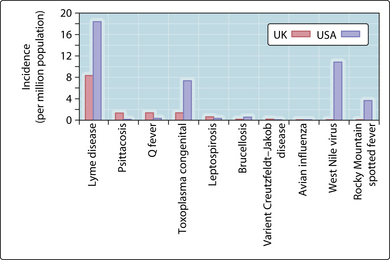31. Zoonoses
 indirect contact though food and water contaminated with excreta or saliva (e.g. campylobacter, Escherichia coli O157 (Ch. 21)
indirect contact though food and water contaminated with excreta or saliva (e.g. campylobacter, Escherichia coli O157 (Ch. 21)Impact of zoonoses
In the UK, zoonotic infections are uncommon, and many that were once endemic have declined or been eradicated (e.g. rabies, anthrax and brucellosis) (Fig. 3.31.1). In recent years, many of the newly recognized infectious diseases of humans have been traced to animal reservoirs (e.g. varient Creutzfeldt–Jakob disease, avian influenza, West Nile fever). Factors influencing such events might include microbial changes at the molecular level, such as acquisition of virulence factors, and modification of the immunological status of individuals and populations. Many zoonoses agents such as Bacillus anthracis, Yersinia pestis, Coxiella burnetii and Franciscella tularensis have gained new interest because they may be used in bioterrorism.
< div class='tao-gold-member'>
Stay updated, free articles. Join our Telegram channel

Full access? Get Clinical Tree












